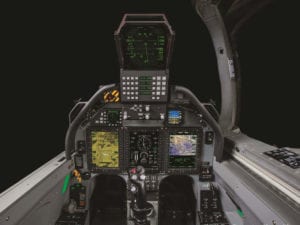
U.S. House and Senate defense authorizers are pushing for a ramp up of the Light Attack Aircraft program to support Special Operations Forces. Pictured here is the CMC Cockpit 4000 avionics suite for the AT-6 Wolverine. Photo: Textron Aviation.
Defense authorizers in the U.S. House and Senate are pushing for a ramp up of the Light Attack Aircraft to support special operations forces (SOF) on the ground.
H.R. 2500 and S. 1790, the House and Senate versions of the Fiscal 2020 National Defense Authorization Act, contain amendments by Reps. John Rutherford, R-Fla. and Michael Waltz, R-Fla. and Sen. Marco Rubio, R-Fla., that would allow U.S. Special Operations Command (SOCOM) to buy the planes after SOCOM certifies a “mission capability gap and special-operations-forces-peculiar acquisition requirement exists which can be mitigated with procurement of a light attack aircraft capability.”
The amendments also provide that the Air Force secretary “shall use or transfer amounts authorized to be appropriated by this act for Light Attack Aircraft experiments to procure the required quantity of aircraft for Air Combat Command’s Air Ground Operations School; and Air Force Special Operations Command for Combat Air Advisor mission support.”
“The light-attack program offers a low-cost solution to absorb missions currently being conducted by 4th and 5th generation platforms,” according to a Sept. 27 letter to the chairmen and ranking member of the House and Senate Armed Services Committees from Sen. Rubio and Reps. Rutherford, Matt Gaetz, R-Fla., Mario Diaz-Balart, R-Fla., Debbie Wasserman Schultz, D-Fla., Bill Posey, R-Fla., Don Bacon, R-Neb., and Mark Amodei, R-Nev.
“By enabling this program, it will allow the Air Force the ability to execute Combatant Commander requirements and task orders in order to preserve high fidelity fifth-generation fighter aircraft such as the F-35 Joint Strike Fighter for a near-peer fight,” the letter said.
As the Air Force continues its light attack aircraft program with the Textron Aviation AT-6 Wolverine and the Sierra Nevada Corporation (SNC)/Embraer A-29 Super Tucano, the military service plans to conduct experiments to ensure that the planes’ avionics networks are compatible with those of other military services and national defense forces.
The Air Force released a final request for proposals Oct. 24 to procure no more than six light attack aircraft in the coming months. The Air Force plans to buy the planes with unused fiscal year 2018 or fiscal year 2019 funds, which would be split evenly between the AT-6 and A-29. Contract award is expected by the end of the year for the A-29 and in early 2020 for the AT-6.
Textron has said that the AT-6 Wolverine is “compatible with all fielded US joint terminal attack controller (JTAC) digital voice/data/video capabilities and with their NATO equivalents.”
The company has said that the aircraft has a CMC Cockpit 4000 avionics suite that is Federal Aviation Administration-certified and that the aircraft uses the same Lockheed Martin combat mission system featured in the A-10C Thunderbolt II. The pilot/vehicle interface and cockpit are similar to that of the Air Force’s F-16 fighter jet, according to Textron.
The AT-6 also has an L-3 Harris Wescam MX-15Di turret giving color and infra-red cameras, a laser designator, laser illuminator, laser spot tracker, and laser range-finder.
For its part, SNC said that the A-29 Super Tucano fulfills the interoperability requirement for the Air Force light attack aircraft program “along with inclusion of Link-16 to enable additional data sharing.”
Air Force Chief of Staff Gen. David Goldfein has said that the program’s focus is how a light attack aircraft can help U.S. allies and partners to confront violent extremism and conduct operations within their borders through a common architecture and a digital network to connect platforms, sensors and weapons.